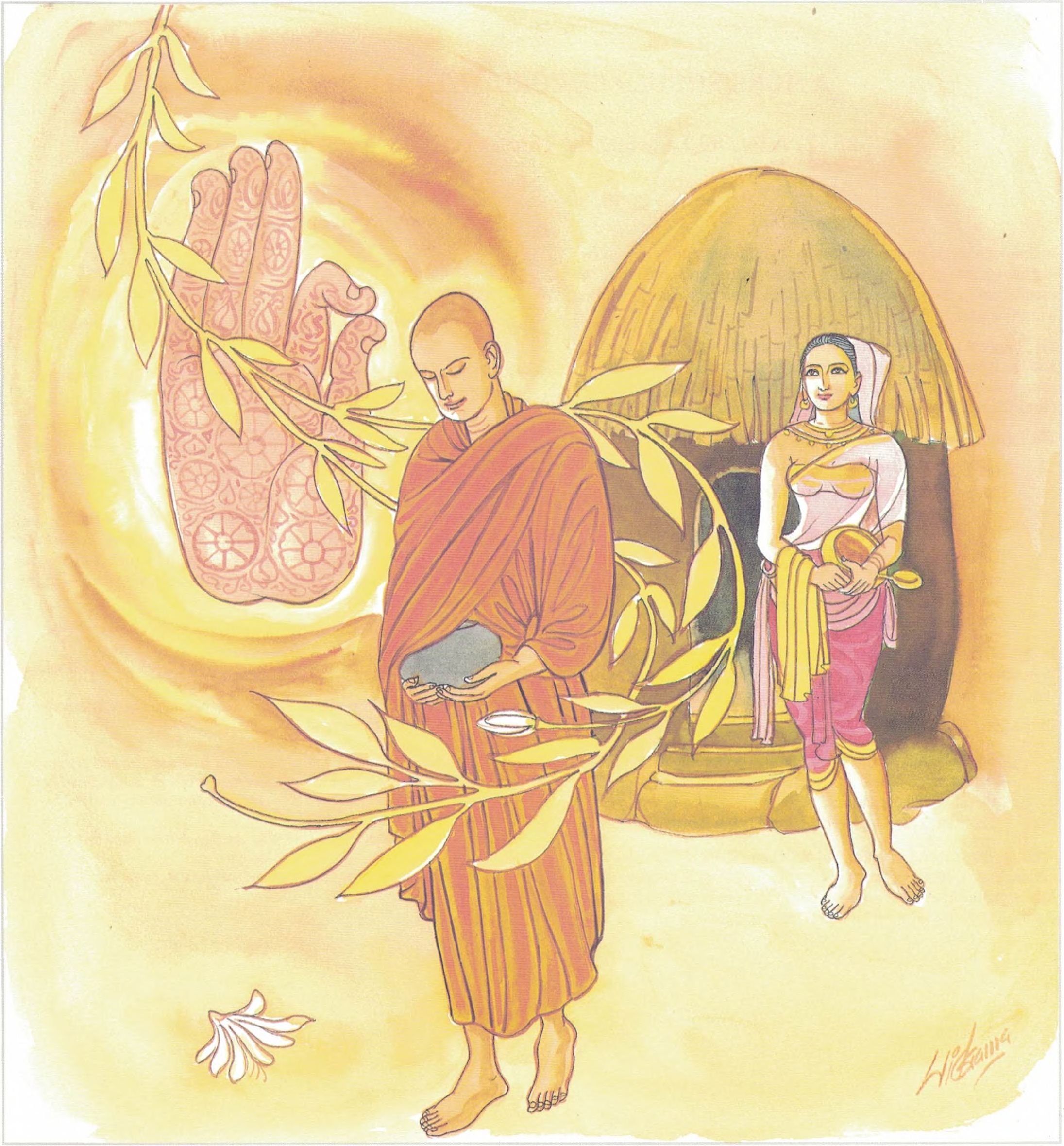Dhammapada (Illustrated)
by Ven. Weagoda Sarada Maha Thero | 1993 | 341,201 words | ISBN-10: 9810049382 | ISBN-13: 9789810049386
This page describes The Story of Meditation on Jasmine Flowers which is verse 377 of the English translation of the Dhammapada which forms a part of the Sutta Pitaka of the Buddhist canon of literature. Presenting the fundamental basics of the Buddhist way of life, the Dhammapada is a collection of 423 stanzas. This verse 377 is part of the Bhikkhu Vagga (The Monk) and the moral of the story is “Like a jasmine creeper its faded flowers, so ye bhikkhus, give up your lust and aversion”.
Verse 377 - The Story of Meditation on Jasmine Flowers
Pali text, illustration and English translation of Dhammapada verse 377:
vassikā viya pupphāni maddavāni pamuñcati |
evaṃ rāgañ ca dosañ ca vippamuñcetha bhikkhavo || 377 ||
377. Just as the jasmine sheds its shrivelled flowers all, O bhikkhus so should you lust, aversion shed.
 Like a jasmine creeper its faded flowers, so ye bhikkhus, give up your lust and aversion. |
The Story of Meditation on Jasmine Flowers
A group of monks from Sāvatthi, after taking a meditation topic from the Buddha, set out for the forest to practice meditation. While thus engaged, they saw jasmine flowers which had blossomed that very morning, dropping in the evening from the stem. Thereupon they thought to themselves, “We will obtain release from lust, hatred, and delusion, before you obtain release from your stems,” and applied themselves to meditation with renewed vigor. The Buddha behold those monks and said, “Monks, even as a flower is released from its stem, even so should a monk strive to obtain release from the pain of birth and rebirth.” And even as he sat within the perfumed chamber, he sent forth a light and pronounced the following stanza,
“Monks! As the withered flower is shed from the plant, so also should a monk strive to free himself from worldly suffering.”
At the conclusion of the lesson, all those monks were established in arahatship.
Explanatory Translation (Verse 377)
vassikā viya pupphāni maddavāni pamuñcati
evaṃ rāgañca dosañca vippamuñcetha bhikkhavo
vassikā: the jasmine creeper; pupphāni: flowers; maddavāni: the withered; pamuñcati viya: just as (it) casts off; evaṃ rāgañca: passion; dosañca: ill-will; vippamuñcetha: cast off from your mind; bhikkhavo [bhikkhava]: O’ monks
The jasmine creeper casts off its withered flowers, Exactly in that manner, O monks, cast off your passion and ill-will.
Commentary and exegetical material (Verse 377)
This verse relates to a group of monks who meditated upon jasmine flowers falling to the ground–their stems detaching from the vine. In several instances, meditators achieved higher knowledge by concentrating on some object. The main purpose of the Buddha’s system of mind-training is to purify the mind from all defilements and corruptions, in order to cultivate its intrinsic pliability so that perfect knowledge may be attained, which is the means of transcending the states of woe and sorrow.
Furthermore, the mental training specified in Buddhism is training in higher thought, in lofty ideals and concentration of the mind upon some principle of a moral and virtuous character. The mind which is wholly given to a single perception of a salutary kind, becomes purely radiant and illuminated in its original state. (pabhassaraṃidaṃ).
In the very beginning, therefore, it is essential to focus the attention upon an object (ārammaṇa) entirely dissociated from the passions, in order to draw a pure mental picture. This picture the meditator retains as his ideal, and trains his mind to concentrate upon it. The mind becomes pure or impure, not through its own nature, but through the arising of pure and impure thoughts. The object for securing the preliminary attention must, therefore, be associated with purity, virtue and truth. Moreover, the object or the ideal selected for meditation must be such as to produce some psychological effect which is suited to the particular disposition of the meditator.
The scriptures record that the Buddha realized the diverse mental dispositions and innate tendencies of those who looked to him for deliverance, and recommended them various methods; and these methods have been ever increasingly developed as it became necessary to extend the opportunity of training in this system to a greater variety of mental types.
These methods were later modified, enlarged and grouped together in different ways forming different schemes of meditation, according to their psychological effect and value in inducing higher states of consciousness, and also with regard to their suitability for various individual characters. They are found in the Nikāyas, in the Abhidhamma and the commentaries, besides other works dealing with meditation, in the form in which they have been practiced and maintained in the Theravāda school.
